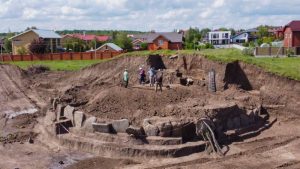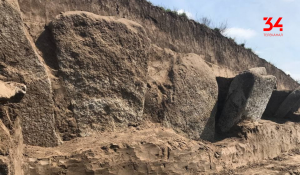The archaeologists state that this “Ukrainian Stonehenge”, an ancient burial ground, is more than 5,300-5,500 years old, dating back to the Bronze Age.


There are numerous kurgans scattered throughout eastern and southern Ukraine and archaeologists and historians are worried that, in many cases, urban sprawl will lead to the destruction of these ancient burial mounds. Thus, they are rushing to excavate as many of them as possible in order to save and preserve priceless items from bulldozers and rapid urbanization.
Such a mound was found near the village of Novooleksandrivka, Dnipropetrovsk Oblast. Items and artifacts discovered in this almost eight-meter hill bear witness to the flourishing of Indo-Aryan tribes who developed an elaborate burial tradition used by the entire population. These tombs illustrate unique characteristics, not only in terms of their number, density and scale, but also in terms of details such as burial chambers, burial gifts and mummified bodies.

Early semi-nomadic pastoral communities from the Ukrainian steppes left few settlements but numerous tombs behind. They are distinguished by a kurgan over the grave and the body laid on the back with bent legs, covered with red ochre. Many graves had weapons (stone battle hammers and clubs), arrowheads and rough clay pots decorated with rope imprints. Some had wheels in the corners to symbolize burial carts.

Excavations in the Novooleksandrivka area began in early April 2021 and dozens of multi-layered graves have been discovered in the mound… from the Bronze Age, the Scythian era and the Middle Ages.
This kurgan, which could become the "Ukrainian Stonehenge”, appeared about 5,000 years ago; it is 7.5 metres high and 50 metres wide, and was probably used as a common burial place for over a thousand years.
A week after the excavations began, archaeologists uncovered skeletons buried in eleven alcoves, broken jugs and monumental boulders encircling the area. Experts and historians presume that chieftains and shamans were buried in this hill.
“The mound is huge, so it’s very likely that many workers and tremendous costs were required to complete it. This means that the persons who are buried here were highly respected in the community. The fellow tribesmen honoured them by building such an elaborate funeral complex,” states Dmytro Teslenko, head of the Dnipro Expedition of the Archeological Service of Ukraine.

Archaeologists note that ancient tribes placed enormous stone slabs in a circle, which they adjusted manually in order to strengthen the entire structure. The tombstones were cut by hand and transported to the burial place by water, horse cart or even sleigh in winter. Specialists estimate that these boulders are 500 years older than the Giza Pyramids of Egypt.
During the excavations, archaeologists uncovered 64 stone boulders and each of them has its own sacred significance.
“This cromlech (megalithic construction made of large stone blocks-Ed) has two functions. First, the boulders act as a retaining wall to hold back the soil and second, they are sacred fences, separating the world of the dead from the world of the living,” explains Yaroslav Yaroshenko, a researcher of the Dnipro Archaeological Expedition.
Archaeologists have also found traces of mummification in one of the ancient burials dating back to the Early Bronze Age. All the internal organs were removed from the body.

“We rarely find such treasures. They will give us knowledge about the people’s lifestyle and their burial rituals,” explains Dmytro Teslenko.
Some skulls are richly decorated and painted with red ochre (red mineral paint). Red ochre staining was probably a religious ritual, which symbolized continued life after death, and testified to the high status of the deceased.
Pastoralist communities did not accumulate possessions, so only every fifth grave contains artefacts: flint tools, wolf-fang necklaces or clay pots.

After the dig has been fully completed and all the artifacts duly recorded, local authorities plan to organize an open-air museum. The cromlech will be in the centre of the museum area. The construction company has promised to bear all expenses incurred.
In turn, local residents have formed a working group and sent an appeal to the Ministry of Culture to maintain the excavated area on the list of memorial sites.


Read More:
- Remarkable find near Khortytsia. Underwater archaeologists raise ancient Cossack gun carriage to surface
- Archaeologists discover Scythian treasure in Poltava Oblast
- Gilded Scythian sword found on Mount Mamai in Zaporizhzhia Oblast
- Sensational find on Khortytsia reveals the remains of an 18th century Cossack encampment
- Hoard of 1000-year-old silver coins with Ukrainian trident found in north Ukraine
- Treasures stolen from Kyiv cathedrals in the 1930s discovered in State Historical Museum in Moscow
- Remnants of a 12th century unique medieval fortification wall discovered in Kyiv
- Sensational find in Khortytsia as archeological team uncovers deep grave of Scythian warrior
- 900-year-old relic found under church floor in Busk, Lviv Oblast
- New dig in Chyhyryn sheds light on a page of Ukrainian Cossack history
- Egyptian mummies found in Kyiv Cathedral
- Stolen ancient viking’s sword from the dawn of Kyivan Rus comes back home to Ukraine





